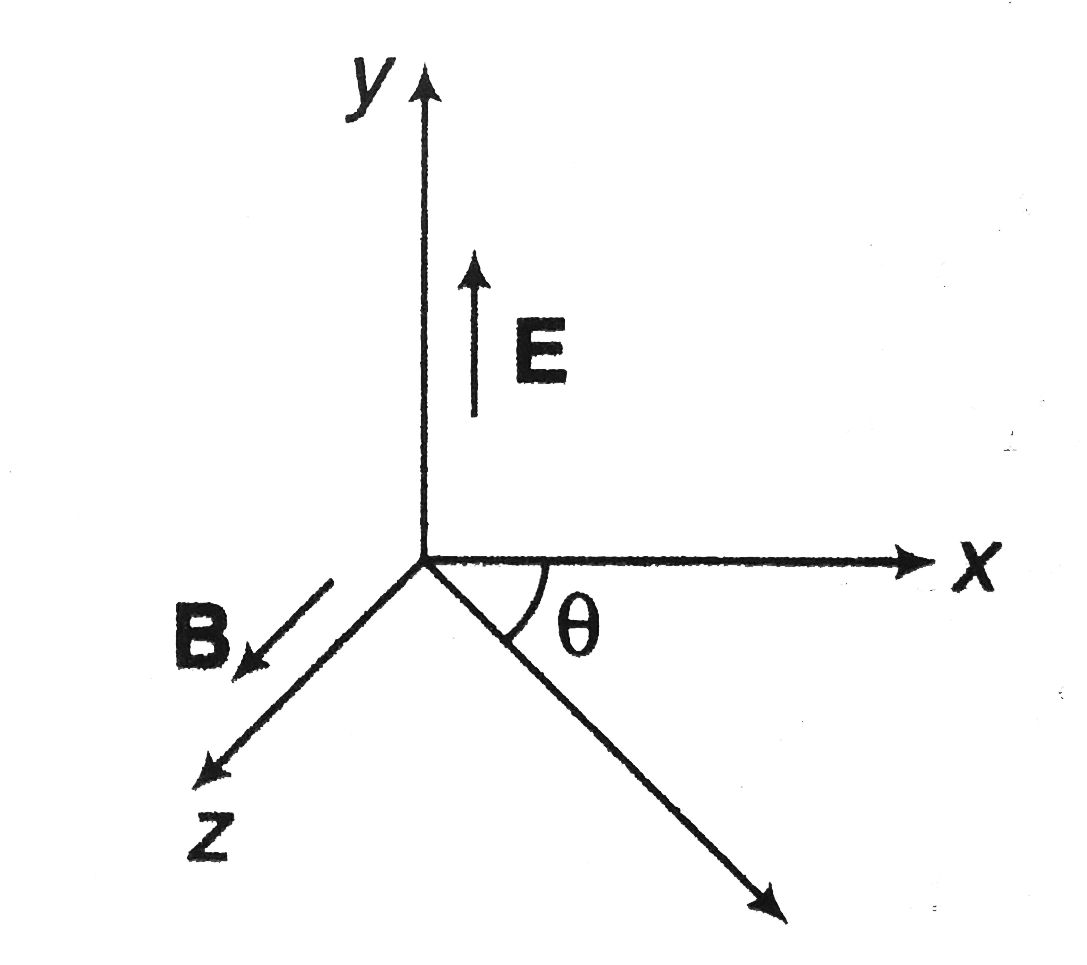A proton beam passes without deviation through a region of space, where there are uniform tranverse mutully perpendicular electric and magnetic field with E = 220 kV/m and B = 50 mT.Then the beam strikes a grounded target.Find the force imparted by the beam on the target, if beam current is equal to i = 0.80 mA
Here the proton beam passes without deviation, hence
Fb=Fe⇒Bev=eE
∴V=EB=120×10350×10−3=2.4×106ms−1
Number of protons reaching per second
nqt=0.8×10−3
or n×1.6×10−191=0.8×10−3orn=5×1015
Total mass of proton reaching per second
=(5×1015)×(1.67×10−27)=8.35×10−12kg
Force=Change in momentumtime
=[(8.35×10−12)(2.4×106)]/1
20.04×10−6N=20.04μN
 .
.
Topper's Solved these Questions
- BOOK - CENGAGE PHYSICS ENGLISHCHAPTER - MAGNETIC FIELD AND MAGNETIC FORCESEXERCISE - Solved Example25videos
MAGNETIC FIELD AND MAGNETIC FORCES
- BOOK - CENGAGE PHYSICS ENGLISHCHAPTER - MAGNETIC FIELD AND MAGNETIC FORCESEXERCISE - Exercise 1.122videos
MAGNETIC FIELD AND MAGNETIC FORCES
- BOOK - CENGAGE PHYSICS ENGLISHCHAPTER - INDUCTANCEEXERCISE - Concept Based8videos
INDUCTANCE
- BOOK - CENGAGE PHYSICS ENGLISHCHAPTER - MISCELLANEOUS VOLUME 3EXERCISE - True and False3videos
MISCELLANEOUS VOLUME 3
Similar Questions
A proton beam passes without deviation through a region of space where there are uniform transverse mutually perpendicular electric and magnetic field with E and B Then the beam strikes a grounded target. Find the force imparted by the beam on the target if the beam current is equal to I .
View SolutionA non-relativistic proton beam passes without deviation through a region of space where there are uniform transverse mutually perpendicular electric and magnetic fields with E=120kVm−1andB=50mT. Then the beam strikes a grounded target. Find the force which the beam acts on the target if the beam current is equal to i=0.8mA.
Mass of protons =1.67×10−27kg.View SolutionNon-relativistic protons move reactilinearly in the region of space where there are uniform mutually perpendicular electric and magnetic fields with E and B. The trajectory of the protons lie in the plane X-Y as shown in Fig. 1.107 and forms an angle ϕ with X-axis. Find the pitch of the helical trajectory along which the protons will move after the electric field is switched off.
 View Solution
View SolutionProtons move rectilinearly in the region of space where there are uniform mutually perpendicular electric and magnetic fields E and B. The trajectory of protons lies in the plane xz as shown in the figure and forms an angle 9 with x-axis. Find the pitch of the helical trajectory along which the protons will move after the electric field is switched off.
 View Solution
View SolutionA proton moving with a constant velocity passes through a region of space without any changing its velocity. If E and B represent the electric and magnetic fields, respectively. Then, this region of space may have
View SolutionA proton moving with a constant velocity passes through a region of space without any changing its velocity. If E and B represent the electric and magnetic fields, respectively. Then, this region of space may have
View SolutionA beam of electrons is moving with uniform velocity in a region having transverse uniform electric and magnetic field of strength. 100 V/m and 0.1 T respectively at right angles to the direction of beam. The velocity of the electrons is
View SolutionAssertion A beam of electron can pass undeflected through a region of E and B.
Reason Force on moving charged particle due to magnetic field may be zero in some cases.View SolutionA beam of electrons is moving with constant velocity in a region having simultaneous perpendicular electric and magnetic fields of strength 20Vm−1 and 0.5 T, respectively at right angles to the direction of motion of the electrons. Then, to move undeflected the velocity of electrons must be
(a) 8m/s (b) 20m/s (c) 40m/s (d) 140m/sView SolutionFollowing experiment was performed by J.J. Thomson in order to measure ratio of charge e and mass m of electron.

Electrons emitted from a hot filament are accelerated by a potential difference V. As the electrons pass through deflecting plates, they encounter both electric and magnetic fields. the entire region in which electrons leave the plates they enters a field free region that extends to fluorescent screen. The entire region in which electrons travel is evacuated.
Firstly, electric and magnetic fields were made zero and position of undeflected electron beam on the screen was noted. The electric field was turned on and resulting deflection was noted. Deflection is given by d1=eEL22mV2 where L = length of deflecting plate and v = speed of electron.
In second part of experiment, magnetic field was adjusted so as to exactly cancel the electric force leaving the electron beam undeflected. This gives eE=evB. Using expression for d1 we can find out em=2d1EB2L2
A beam of electron with velocity 3×107ms−1 is deflected 2 mm while passing through 10 cm in an electric field of 1800V/m perpendicular to its path. e/m for electron isView Solution
